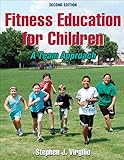Fitness education for children : a team approach / Stephen J. Virgillo
By: Virgillo, Stephen J [author]
Publisher: Champaign, Illinois : Human Kinetics, 2012Edition: Second editionDescription: xi, 259 pages : illustrations ; 28 cmContent type: text Media type: unmediated Carrier type: volumeISBN: 9781450402552Subject(s): Physical fitness for children -- Study and teaching -- United States | Teaching teams -- United States | Curriculum planning -- United States | Physical education for children -- Study and teaching -- United StatesDDC classification: 613.7042| Item type | Current location | Home library | Call number | Status | Date due | Barcode | Item holds |
|---|---|---|---|---|---|---|---|
 BOOK
BOOK
|
HIGH SCHOOL LIBRARY - JHS | HIGH SCHOOL LIBRARY - JHS SUBJECT REFERENCE | 613.7042 V81 2012 (Browse shelf) | Available | CITU-HS-JHS5929 |
Pt. I. DEVELOPING A FOUNDATION -- ch. 1. A new perspective in elementary physical education -- Heart disease begins in childhood -- Physical activity as a key factor -- National physical activity plan -- NASPE physical activity guidelines for children -- Physical activity philosophy -- Components of health-related physical fitness -- Sport-related physical fitness -- Fitness education -- Summary -- ch. 2. A team approach to fitness education -- Mixed messages -- Multidisciplinary team approach -- Comprehensive school physical activity programs -- Let's move and let's move in school -- School wellness plan -- Health-related physical fitness testing -- Youth fitness tests -- Presidential active lifestyle award -- Authentic assessment -- Summary -- ch. 3. Behavioral change and motivational strategies -- Rainbow to youth fitness and active lifestyles -- What motivates children to move? -- Types of motivation -- Motivational strategies -- Summary -- ch. 4. Principles of health-related physical fitness -- Core principles of health-related physical fitness -- Stages of a physical activity session -- Components of health-related physical fitness -- Summary -- ch. 5. Fitness education for children with disabilities -- Individualized education plan -- Guidelines for inclusion -- Obesity -- Asthma -- Autism spectrum disorder -- Spinal cord disabilities -- Intellectual disability -- Summary -- pt. II PLANNING AND TEACHING FITNESS EDUCATION -- ch. 6. Teaching strategies -- Traditional teaching models -- Humanistic approach to teaching fitness -- Spectrum of teaching styles -- Instructional technology -- Class structure -- Summary -- ch. 7. Planning for fitness -- Sample yearly plan for developmental level III -- Sample lesson plans -- Fitness education lessons -- Fitness integration lessons -- Summary -- ch. 8. Teaching health-related physical fitness concepts -- Strategies for teaching fitness concepts and active lifestyles -- Scope and sequence -- Developmental level I fitness concepts: physical activity is fun -- Developmental level II fitness concepts: the best I can be -- Developmental level III fitness concepts: let's get heart smart -- Summary -- ch. 9. Collaborating with the classroom teacher -- Interacting with the classroom teacher -- Communication strategies -- Thematic units: an approach to integrated learning -- Cardiovascular health: a thematic unit -- Health-related physical fitness classroom activities -- Developmental level I classroom activities -- Developmental level II classroom activities -- Developmental level III classroom activities -- Summary -- ch. 10. Getting parents and your community involved -- Establishing a plan of action -- Communication -- Parent education -- Parent participation during school hours -- Home-based activities -- Community involvement -- Summary -- pt. III FITNESS ACTIVITIES -- ch. 11. Developmental exercises -- Cardiorespiratory endurance -- Muscle fitness -- Flexibility -- Exercises to avoid -- Summary -- ch. 12. Active games -- Characteristics of developmental games -- Promoting physical activity through active games -- Developmental level I games -- Developmental level II games -- Developmental level III games -- Summary -- ch. 13. Dance and rhythmic activities -- Safety precautions -- Planning developmentally appropriate activities -- Developmental level I dance and rhythmic activities -- Developmental level II dance and rhythmic activities -- Developmental level III dance and rhythmic activities -- Summary -- ch. 14. Yoga for children -- Helpful hints -- Breathing poses -- Standing poses -- Kneeling poses -- Sitting poses -- Lying poses -- Support poses -- Games -- Summary -- ch. 15. Schoolwide events -- Fitness field day -- Fit for life family night -- Geography run -- School health fair -- Early bird wake-up and afternoon perk-up -- Jump rope for heart, hoops for heart, and step for heart -- ACES: all children exercising simultaneously -- Recess workouts -- Fitness clubs -- Principal walks -- Holiday classics -- Summary.
Emphasizes the importance of collaboration to combat obesity and promote active lifestyles. This book shows how you can engage with the efforts of physical educators, classroom teachers, school volunteers, parents and others in the community by offering information on incorporating the team approach to help schools meet wellness policy objectives.
600-699 613.7

There are no comments for this item.